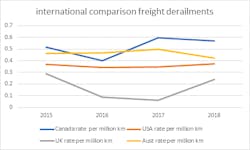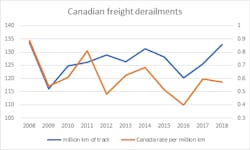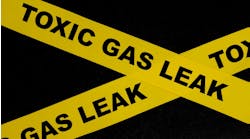Podcast: Transporting Dangerous Cargo Via Train -- What Could Go Wrong?
Trains carrying dangerous cargo like crude oil -- is it the right way to go? Applying process safety principles like inherently safer design could prevent derailments, explosions and deaths. In this episode, Trish & Traci examine the recent uptick in crude oil derailments and what could be done to prevent them.
Transcript:
Traci: Welcome to this edition of "Process Safety" with Trish & Traci, the podcast that aims to share insights from current incidents to help avoid future events. I'm Traci Purdum, senior digital editor with Chemical Processing. And as always I'm joined by Trish Kerin, the director of the IChemE Safety Centre. What's new Trish?
Trish: Oh, not a lot at the moment, Traci. It all seems to be a little bit of the same old, same old as we continue through this pandemic, doesn't it? Every day is another day, but we're not sure what day it is.
No worries! Subscribe and listen whenever, wherever.
Traci: Indeed. We're getting ready for the 4th of July weekend, our Independence Day. And there's actually a fireworks display that's socially distanced. You can stay in your car. So my husband and I are contemplating going to that. But everything is sort of the same but then different. So yeah, it's an interesting time.
Trish: That's pretty cool that they've made it easier for you to be able to still enjoy the fireworks and celebrate the 4th of July. That's really good.
Traci: They're selling tickets, and so it's a limited parking area in there. And you have to stay in or near your car. So, it should prove interesting.
Trish: You can go and do your whole tailgate party thing if you've got to stay just near your car.
Traci: Exactly. We could pack a picnic and have fun.
Trish: Yeah. Sounds good.
Traci: Well, for today's episode, I'd like to delve deeper into a conversation you and I had about train derailments in Canada. It stemmed from an investigative piece you read from the CBC News/Radio Canada. And July 6 marks the seven-year anniversary of the rail disaster at Lac-Mégantic, Quebec, that killed 47 people. So it's kind of a timely topic for us. And since that Lac-Megantic incident, there have been seven major derailments of crude oil trains in Canada. In each case, the investigators blamed broken track. Is this number normal for Canada and for the rest of the world?
Trish: I have to admit, it took me a little bit by surprise because, you know, we heard about Lac-Mégantic and we all knew how tragic that incident was. And it was really a surprise for me to see this article pop up from a friend in Canada, and say, you know, they're still happening. Because I don't think the rest of the world realized that these train derailments were still happening in Canada, with crude oil, or with a hazardous cargo on them.
Source: Trish Kerin, director IChemE Safety Centre
I mean, train derailments occur. And it prompted me to go and look at some other countries around the world, to see what their derailment rate was, for example. And so I looked at the U.S., I looked at the UK and I looked at my own home country, Australia, and did a little bit of a comparison between them. And it was interesting to see that the rate per million kilometers of track...and I normalized it to kilometers, not miles. I had to convert. That was where most of the data was available in. Canada does seem to be a little bit of an outlier and sitting at a bit higher in terms of freight derailment. The UK is quite low, relative, the U.S is sort of the next one, and then my own country, Australia, is like the third if you look at the frequency graph I created, followed by...then you see Canada right at the top of that graph. And that made me wonder what was going on? What was different about Canada?
I've actually traveled trains in Canada, so I was really quite curious to understand, you know, do they just have a lot more track? Do they do a lot more freight? It's an interesting question. But the other fascinating thing is that last week or earlier this week, it was actually the anniversary of another train derailment that occurred, that is very...it's well known in Europe, but not very well known anywhere else in the world. And it was an LPG train that derailed in a village called Viareggio in Italy. And, indeed similar to Lac-Megantic, there were 32 people killed in that. So Lac-Megantic, I think was 47, from memory. But, you know, 32 were killed in Italy from that LPG train derailment as well.
Traci: Now, broken track seems straightforward, but is there's something else going on here? It seems like a strange uptick in number.
Trish: That was what really made me curious about this, which is why I made sure I looked at the U.S. as a comparative country. And I wondered whether there was something weather-related. You know, we know that in Canada, it gets very cold in winter and there's a lot of snow and a lot of ice, and then in summer, it can still get quite warm. Relative, in the northern half of the U.S., you see the same thing. You know, up where you are, you have snow, you have ice in winter, but in summer, it can be quite pleasant and warm as well. So if you think about it, steel railway tracks then suffer an enormous amount of contraction and expansion over a year-long period as they go from very cold to very warm. I wondered whether that was part of it.
Source: Trish Kerin, director of ICheme Safety Centre
I mentioned when I started this, that I have caught a train. I've done the train that travels from Toronto to Vancouver. That's four days, I think it was on a train. It was a lovely journey. Did it with a couple of friends. And as we were going along, there was a couple of times where I saw on the side of the tracks that there was a little LPG gas bottle. And I thought, "I wonder what that's for?" And I spoke to the conductor. And it's used to create... They have to run a heating system that actually has to heat the points of the track because when they do change the points in the middle of winter, they can get iced up. So, they need to make sure that they can actually defrost sufficiently to move. And so I wonder whether there is something there in terms of just the simple temperature impact on the steel, as well as there are some parts where you certainly travel very, very fast. I remember as we went across the prairies, that train was absolutely flying as it went across the prairies of Canada.
So, you know, I love doing train journeys, and in fact, I had... I was meant to be doing a train journey in Central Canada, but that's, unfortunately, been postponed until next year now. As my friend and I joke about it. We often just turn to each other and say, "I like trains." And we love traveling on trains. But it does, kind of, make you think twice at some point around the safety when you see so many broken track issues.
Traci: Indeed. And I wonder. Now you may not know this off the top of your head. But is it just an older rail system up there? Is it just that much older than the rest of the UK and the U.S. and Australia that you're looking at? Maybe the train track is just older.
Trish: That's unclear. It's a bit hard to find out some of that information. But I think, relatively, there's a lot of aged tracks all over the world. I'm not sure it's an age of the track. The CBC article suggested there's perhaps some maintenance-related issues with it, though I couldn't comment on that. I haven't inspected it. I'm not a rail expert. I haven't seen their maintenance records. But certainly, as part of their expose in their article, they did look at the auditing and the number of faults found. And as I said, if you think about the things like, how much stress is on those tracks and the joint bars that actually join together the two pieces of rail, as I said, they would be under enormous tension and compression that would occur, and you could potentially see some quite significant shearing of the bolts connecting the joint bars to the rails, I would imagine.
Traci: And definitely that speed going across, it's just like crossing, you know, ice. You do it gingerly and slowly. If you go quickly, it breaks. So, it kinda makes sense there.
Trish: Yeah, yeah.
Traci: And reading on, this document suggested the government regulator, Transport Canada, is failing to properly oversee rail companies and ensure safety. And you did mention those compliance issues that they had. Do you think this the case, that the Transport Canada is not overseeing properly? And is there any obligation for the oil companies to also inspect these tracks? I mean, that's a lot of their product being lost. Is it in their best interest to maybe also inspect the tracks that they're going to be traveling on?
Trish: Yes, I think there is an obligation by the oil companies. It is their product. They are responsible for that product from the start to the finish. If it was going through a pipeline and the pipeline raptured, they'd still be responsible for the pipeline, for the cleanup associated with the oil spill potentially. In terms of Transport Canada, look, I couldn't speak to whether they're failing as a regulator. Though, you would certainly suggest that perhaps they should be taking a closer look at some of the maintenance on the critical rail aspects of the train system that they have there. Because, you know, we're averaging one major oil train derailment a year. Those derailment figures I looked at were not only for oil. Because that's one of the other things that's slightly different here.
In Canada and the U.S., you see a lot of oil transported by train. In the UK and Australia, we don't move oil by train. We move oil by pipelines, typically. So, there's a lot less opportunity for a dangerous cargo to potentially derail in Australia, for example, because the dangerous cargo, typically, is not on the train in the first place. So derailments occur, you then start looking at the magnitude of that derailment. What is the issue here?
And the tragedy we saw at Lac-Mégantic, was 47 lives lost with that explosion and fire. In addition to that, the significant volume of oil that spilled in the subsequent seven oil derailments that have occurred. So I think it's hard to comment on how Transport Canada are actually dealing with it without seeing their complete regime and seeing them in action. But I do think that the oil companies really need to be taking accountability for their cargo. After all, they want their cargo to get to the other end. They should be making sure that when that cargo is being transported, that it's being transported safely. They'd have to do that if it was being transported in trucks, they'd have to do it if it was being transported in pipelines.
An example, again in Australia, is we have, in the road transportation sector, what we call the chain of responsibility legislation. And what that actually says is that everybody along the chain is responsible for the cargo being transported. So if there is a fatigue-related truck crash, for example, it can be traced back to the owner of the product on the truck. Did they do anything at all that pushed the driver or the company to drive that a little bit longer and have a fatigue-related issue? So the consigner is responsible. The consignee is responsible. And everybody in between is responsible and can be prosecuted in that instance. You can go up and down the chain, depending on where the pressure in the system has come from. You know, you wonder whether something like that might be useful to really make sure that people are focusing on looking after the infrastructure that transport their dangerous cargos.
Traci: Indeed. And thinking about this as well, and you, kind of, brought this up a little bit. You know the responsibility for the cleanup. Six of the seven derailments resulted in spills. And it was 8.4 million liters of crude oil that spilled. Who cleans that up? Both the railway and the refinery?
Trish: Yeah, it's an interesting question. And again, it's going to come down to the specific environmental laws in Canada. But you would have to be thinking that the owner of the crude oil would have some accountability to make sure that they were part of that cleanup process. Because at the end of the day they are choosing people to transport their product. They need to make sure that they select trains with the appropriate rail cars, so that they have integrity, and so the rail cars themselves don't leak, but also, you know, is there some way they can be further protected in case of a minor derailment? And then making sure that the train tracks themselves are in a good condition. So I would suggest that if they should be doing that, they probably should be responsible for some of the cleanup as well.
But certainly, the rail companies can't be excluded from this. If it's their train, sort of running on tracks that they either own or that they're leasing the track journey rate, then they should also be responsible for that cleanup. And 8.4 million liters of crude is a substantial volume of crude that's been spilled across many, many different communities in Canada. Fortunately, there hasn't been fatalities from the other seven. But there have been fires. You know, they were probably lucky that they didn't have fatalities in some of those other seven, I suspect.
Traci: And I think in that article I read, or watching some sort of video, that they were talking about the size of the trains that were going. They were bigger. They were passing more across those tracks. Maybe thinking of different ways to mitigate this is to go with shorter loads, smaller loads on those trains. Is that something to consider or...?
Trish: Well, the challenge you've got there, if you go for smaller loads and you still need to move the same volume of crude oil, that means you're moving more trains, which is more dynamic stress on the train line as well because you've got a train going across and then the train line doesn't suffer any dynamic stress while there's no train on it, then you put another train across, and another train across. So, I can understand why they've increased the length of the trains, it means less trains. But the length of the trains, if they do derail, then obviously, can take a lot more carriages with them, and potentially then lead to much more substantial spills.
I mean, I know that it's often a big environmental and political debate as to, you know, what is the best way to transport some of this product? Should it be via pipeline? And I know that there's been a lot of protests and a lot of concerns about the installation of pipelines around the place. And pipelines aren't the panacea. They don't fix everything. Pipelines have problems too. Pipelines can be inadvertently struck if they're not adequately protected, you've got corrosion in them, you can have flange leaks in them. There are all sorts of things that can happen with a pipeline. But it's probably a less dynamic system than train transportation. You know, the trains also rely on there being no cars at the level crossing. Because there will be level crossings on these lines, and they won't be as protected as your standard level crossings if you have them in suburban areas because they're generally out in the middle of nowhere, in very, very small villages and towns.
So, you know, a misplaced...a car broken down, another truck driving along that hasn't seen or noticed the train and pulls onto the track to cross it. These are all sorts of things that can significantly impact the safety of rail because you can't have a fence along the entire rail line. That's just not practical to do. So, I think one of the challenges is, we really need to look at what is the best overall outcome from an inherently safer design perspective. Is it trains? Is it pipelines? Is it road transportation? Is it ship? Obviously shipping to the middle of Canada is not practical. But, you know, you need to think about some of those things. So for example, if we want to move, typically, product from Melbourne to Perth, in Australia, it goes on a ship. We don't do hazardous cargoes on the train and we don't do them on roads typically. There's some that do. But if you want to move a substantial volume of hazardous product, you put it on a tanker, and you sail it around the base of Australia to get to the other side. So, you know, there's all sorts of different modes of transportation you can pick, generally. You've got to make sure that we're picking the inherently safer option, not necessarily just the way we've always done it.
Traci: A lot to think about there. And thinking about the other countries, so your trend line sharply increased for Canada starting in 2016, while the UK, U.S. and Australia, as you mentioned, remained flatter, even decreased. Is there a worry that what's happening in Canada could also impact other countries and then obviously putting into practice the inherently safer design questions?
Trish: Yeah, it certainly could. It could create public unrest, where people just really start to protest about the idea of trains being used to carry these dangerous goods. Because the other thing is that the train line typically, if you are in a small town or village along the train line, the train line runs right through the middle of your town, typically. It's not spaced further away. So there is a risk at that point. The interesting thing is, I also looked at the million kilometers of track in Canada. And it was interesting to see that there was a substantial uptick in the number of miles of track traveled from 2016 as well. So, a lot more track, a lot more trains, and that led to more incidents. Though, as I said, I did normalize those incidents against the million kilometers of track. So I think the real number of incidents also must have gone up substantially with their track numbers to have increased that rate that we saw.
And to put it in context, we're talking about... The UK is roughly a third of the freight derailments of Canada. Now, the UK is obviously a much, much smaller country. They don't have nearly as many tracks, but they have a lot of train operations that go on in the UK in terms of freight. So we're certainly seen that. And as I said, the breakdown is the number of freight trains versus the number of dangerous cargoes or, you know, crude oil type cargoes on those trains. We wouldn't be seeing these sorts of concerns I don't think, if it wasn't crude oil that explodes and burns, being carried in these trains.
Traci: Now, forgive my ignorance on this question. But are there dedicated lines for hazardous cargo? I know when you're on the highway, at least in the U.S., some highways say no hazardous cargo for trucks. Can trains just go on any track with hazardous cargo or are there dedicated places for trains to actually travel?
Trish: There's probably going to be some specific lines that they're excluded from for various sensitivity reasons. But on the whole, if you're looking at the train line across Canada, then there's not that many tracks, so you can't have a freight track and a passenger track. They're often the same. And I can certainly vouch for that, as I said, when I did the train ride. The company that does the passenger train across Canada, doesn't own the track. It actually rents the use of the track to go across, which means that the owners of the track are the people that transport the freight. They have priority on the track. So, for the first couple of days, as we crossed the Canadian shield, we spent several hours each day over in a rail siding, as the freight trains went past us. So we were stationary. We'd have to pull off the main track so that the freight trains could just keep hammering through those lines. And then we'd get to go back on the track when the track was clear again, and we can resume our journey.
As I said, then when you get to the prairies, if there's no freight trains on them at that point in time, they make up speed. They make up time. They go flat out across the prairies because, obviously, it's fairly straight and flat at that point. And you could certainly feel the train absolutely rattling along. So it's not like we don't have multi lanes typically on rail like we do on highways. And you can't just build an extra lane. It's not as easy to do in a track because you've got all of the foundation that needs to go. So, the roads still needs foundation, but then you've got to deal with the railway sleepers underneath the rail lines and making sure that all of them are specifically maintained. There's a lot of individual components on a train track, and they all need to be checked and maintained because any one of them suffering a slight piece of damage could result in a derailment, especially if a train hits it at speed. And that example in Italy I mentioned, in Viareggio, it's believed that there was...that the train carriage itself, actually suffered a fatigue fracture in its axle that caused it to derail. And that wouldn't have been such a problem, except beside the rail line, was a big stake sticking out of the ground. And it was that steak that damaged and ripped open the LPG tank on the carriage.
Traci: Oh, jeez.
Trish: So you've also...you know, you've got to be aware of what's around your tracks as well not only what the tracks are in front of you.
Traci: Well, Trish, is there anything you want to add that I didn't touch on in terms of questioning?
Trish: No, not specifically. I think it is an area, perhaps, that we need to just more generally think about, and think about whether trains and dangerous cargoes are the right way to go. If they are, then I think we need to make sure that the appropriate maintenance is done. And these are all standard "Process Safety" questions. So let's talk about the inherently safer design option. And if we do decide to build something, let's maintain it appropriately and monitor it, and have the assurance that it's actually going to function the way we need it to so that we can continue with safe operation. So it really is just those fundamental "Process Safety" principles, which is interesting because we're talking about trains. Something you wouldn't necessarily associate with "Process Safety" principles.
Traci: And as always, you are a marvel with process safety and can apply it to anything, including trains. So I appreciate your time today. And we both know unfortunate events happen all over the world, and we will be here to discuss and learn from them. On behalf of Trish, I'm TracI, and this is Process Safety with Trish & Traci.
Trish: Stay safe.
Check out all the episodes of Process Safety With Trish & Traci.
Want to be the first to know? Subscribe and listen to Process Safety With Trish & Traci on these platforms





